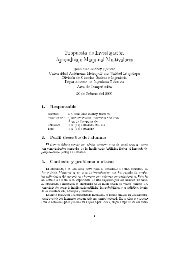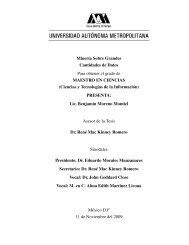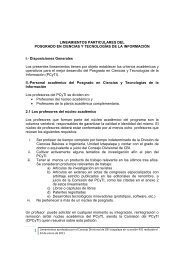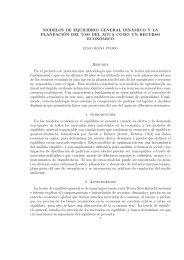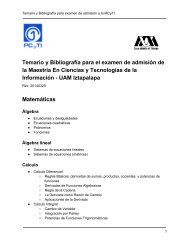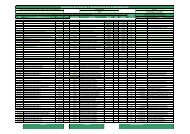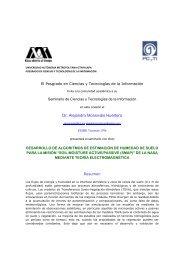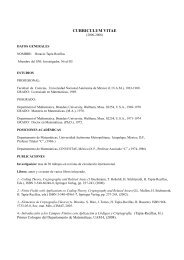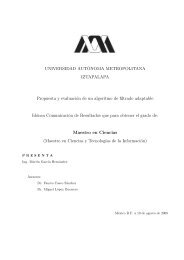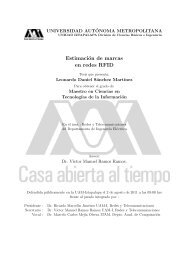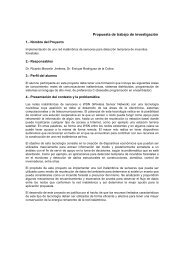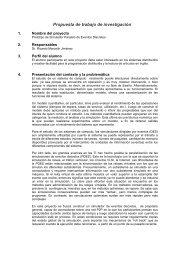enriquecimiento del conocimiento previo en programación lógica ...
enriquecimiento del conocimiento previo en programación lógica ...
enriquecimiento del conocimiento previo en programación lógica ...
You also want an ePaper? Increase the reach of your titles
YUMPU automatically turns print PDFs into web optimized ePapers that Google loves.
REFERENCIAS 18[12] U. M. FAYYAD AND K. B. IRANI, Multi-interval discretization of continuous-valued attributes forclassification learning, in IJCAI, 1993, pp. 1022–1029.[13] A. FRANK AND A. ASUNCION, UCI machine learning repository, 2010. http://archive.ics.uci.edu/ml.[14] J. H. HOLLAND, Adaptation in Natural and Artificial Systems, The University of Michigan Press,1975.[15] E. B. HUNT, Experim<strong>en</strong>ts in induction, Academic Press, New York, 1966.[16] M. I, Newgem: Program for learning from examples technical docum<strong>en</strong>tation and user’s guide., tech.report, Departm<strong>en</strong>t of Computer Sci<strong>en</strong>ce, University of Illinois, Urbana Champaign, IL, 1985.[17] J. JAFFAR AND J.-L. LASSEZ, Constraint logic programming, in POPL, 1987, pp. 111–119.[18] H. KIM AND W.-Y. LOH, Classification trees with unbiased multiway splits, Journal of the AmericanStatistical Association, (2001), pp. 589–604.[19] W. V. LAER, S. DZEROSKI, AND L. D. RAEDT, Multi-class problems and discretization in icl (ext<strong>en</strong>dedabstract), in In Proceedings of the MLnet Familiarization Workshop on Data Mining with InductiveLogic Programming (ILP for KDD, 1996, pp. 53–60.[20] W. V. LAER, L. D. RAEDT, AND S. DZEROSKI, On multi-class problems and discretization in inductivelogic programming, in Proceedings of the 10th International Symposium on Foundations ofIntellig<strong>en</strong>t Systems, ISMIS ’97, London, UK, 1997, Springer-Verlag, pp. 277–286.[21] N. LAVRAC, S. DZEROSKI, AND M. GROBELNIK, Learning nonrecursive definitions of relations withlinus, in Proceedings of the European Working Session on Machine Learning, EWSL ’91, London,UK, UK, 1991, Springer-Verlag, pp. 265–281.[22] W.-Y. LOH AND Y.-S. SHIH, Split selection methods for classification trees, Statistica Sinica, (1997),pp. 815–840.[23] D. MALERBA, F. ESPOSITO, G. SEMERARO, AND S. CAGGESE, Handling continuous data in topdowninduction of first-order rules, in AI*IA, 1997, pp. 24–35.[24] S. MUGGLETON AND L. D. RAEDT, Inductive logic programming: Theory and methods, Journal ofLogic Programming, 19/20 (1994), pp. 629–679.[25] J. R. QUINLAN, Learning logical definitions from relations, Machine Learning, 5 (1990), pp. 239–266.[26] A. SRINIVASAN, The Aleph Manual, 2004. http://www.comlab.ox.ac.uk/activities/machinelearning/Aleph/.



